Critical Mass Systems
Center Stage2M Footers
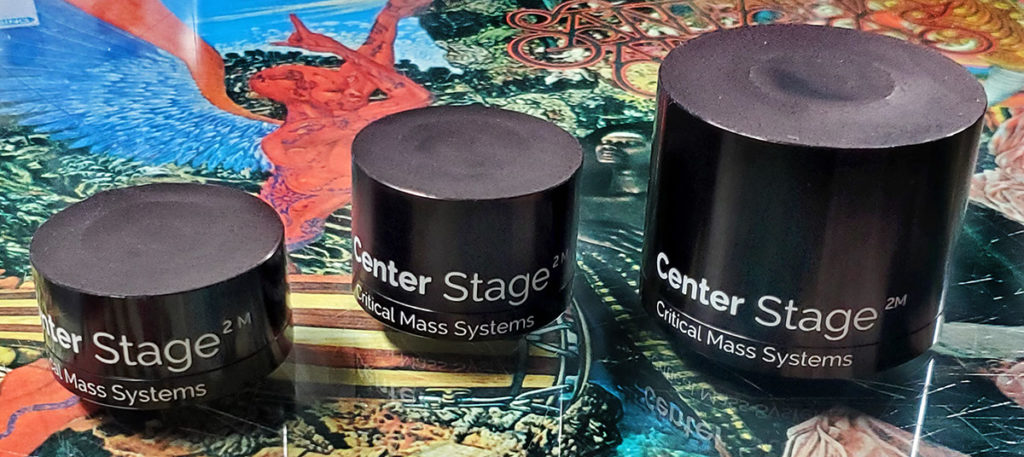
If you’ve seen either of my first two assessments of the earlier iterations of the superb CenterStage footers, both the original and the v2, from Critical Mass Systems, you’ll likely be aware that I awarded them the honor of “Accessory of the Decade: 2001-2010.” They are so unlike any footer or other isolation product I have used over the decades since the category first appeared in the early 1980s that they simply demanded that degree of recognition. Then, last August, Joe Lavrencik, the principal at CMS, said he had enhanced their performance…further still.
Now, I’m not going to rehash the original discussions on the technology or the earlier experiences here; you may see all that in the original assessments, from May (HERE) and December (HERE) of 2018. However, Joe has since shared some additional information about their development.
There were three basic objectives behind the development of Center Stage2M. Firstly, the choice was made to incorporate and build upon what was learned developing the LS (Loudspeaker) series of Center Stage2 products. Further, each new Center Stage2M product should clearly outperform its current Center Stage2 counterpart across the audible spectrum. Finally, and perhaps most interestingly, the objective was to offer a Center Stage2M product that would leapfrog the performance of its bigger sibling in the existing CS2 lineup. In essence, the Center Stage2M 0.8 should outperform the CS2 1.0, the Center Stage2M 1.0 should outperform the CS2 1.5, and the Center Stage2M 1.5 should set yet an entirely new benchmark for audio footer performance in the industry.
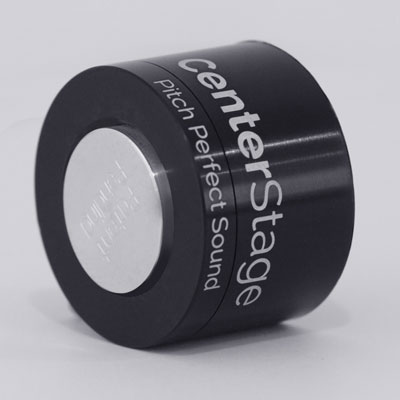 The website tells us that by further implementing tested design fundamentals from within the discipline of material science to determine both the correct sequencing and use of the Center Stage2M materials, they were able to establish what they now define as the proper “proportional applications” of all the materials. Finally, they were able to address the inclusion of the proper amount of added damping in their very last stage to eliminate the internal noise of both the footers, and the component resting on them, without rolling off the top end of the acoustic envelope.
The website tells us that by further implementing tested design fundamentals from within the discipline of material science to determine both the correct sequencing and use of the Center Stage2M materials, they were able to establish what they now define as the proper “proportional applications” of all the materials. Finally, they were able to address the inclusion of the proper amount of added damping in their very last stage to eliminate the internal noise of both the footers, and the component resting on them, without rolling off the top end of the acoustic envelope.
These unique footers allow components resting upon them to reach their engineered potential by following three distinct courses. First, they mitigate the influences of the vibrations coming up from the surface below them. Second, they cancel out their own noise; no simple or common fete, and a rather unique one, in my experience with other footers. Finally, they transfer entropy out of the component! This final aspect of their performance requires time and is the reason for the extended settling process. More on that soon enough.
Critical Mass Systems principal Joe Lavrencik has further shared that the internal composition of these footers follows both the materials composition and sequencing found in his award-winning Critical Mass Systems OLYMPUS racks. Joe explains that the shelves in his racks function essentially as complex filters. The remarkably effective OLYMPUS shelf filtration was miniaturized and applied to both the CS and LS designs. Cutting open one of the footers would reveal little of any consequence to an untrained eye. But essentially you would be viewing a miniaturized version of the OLYMPUS superstructure, precisely recalculated to mismatch impedances to achieve the desired effect. In the case of the Center Stage2M footer, that is a controlled ringing in a predictable bandwidth. While all materials produce noise, controlling that noise so that it can be exploited to reach a net result, to achieve the desired effect, was the goal here.
The website adds, “It might be more appropriate to view Center Stage2M as the counterbalance to a destructive energy cycle within your components. Center Stage2M will greatly reduce unwanted damaging energy and permanently hold a more peaceful state of equilibrium. The pleasant surprise is the wonderful sonic envelope that results.”
Given my astonishingly rewarding experiences with the two predecessors, I was more than merely curious to get the Center Stage2M units into my system. Joe originally sent me eight of the 1.5-inch units, four each placed under my mono amps, four of the 1.0-inch units, placed under my linestage, and four of the 0.8-inch units, place under my DAC.
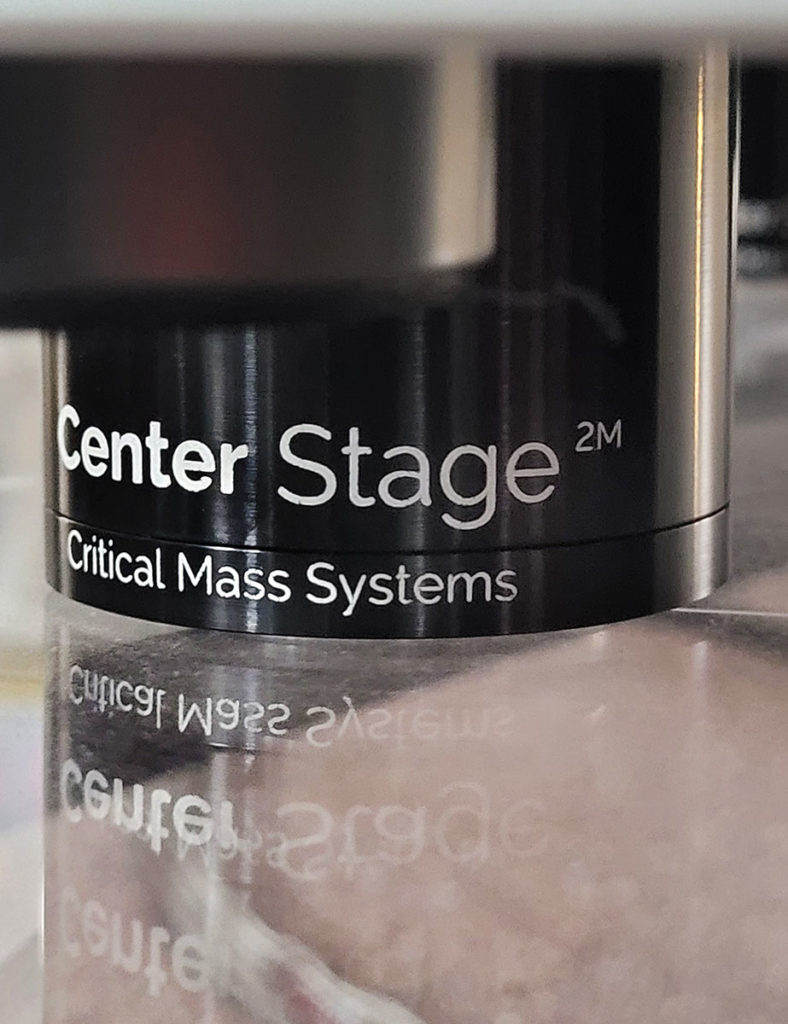 I’ll admit to finding it hard to imagine that Joe could have somehow found a way to leverage any further significant sonic enhancement from this new model over the remarkable performance he had extracted from the Center Stage2 over the original Center Stage. I should have known better!
I’ll admit to finding it hard to imagine that Joe could have somehow found a way to leverage any further significant sonic enhancement from this new model over the remarkable performance he had extracted from the Center Stage2 over the original Center Stage. I should have known better!
To this point, much has been made of the somewhat unique “break-in” path followed by this singular product. The wide range of spectrum change wrought during the settling period after these footers are installed is markedly diverse and almost manic in its nature at times. At one moment, a previously glorious-sounding system may be reduced to a state of near unlistenability – revealing lean, flabby, one-note bass, flat, dimensionless staging, and imaging that may, at any point, change from wandering to bloated to constricted. Wait just another hour to hear that it may sound somewhat normal again, only to have yet another shift, perhaps offering an amazing degree of space and focus, just another hour later. What I found utterly spooky is that, while sitting at my desk, just to the extreme right and some six feet behind the prime listening position of my reference system, catching up on emails and other correspondence, I could clearly note both frequency and spatial changes occurring!
It is significant to note that this challenging run-in period seems to be shorter with the 2M iteration than either of the two earlier versions. While the first version seemed to take its time with its see-sawing changes, from horrible, to good, to bad, and finally back to wonderful, for as many as three weeks – or more, the Center Stage2M seems to shed its most drastic variations within as few as seven, to maybe ten, days.
Now, it occurred to me that I may be assuming too much here, that maybe I was jumping the gun, somehow missing the occasional last-minute, random and rapid scurry back to the dark side before they had finally settled to provide their brazen magic. To that end, I reached out to two other listeners, both of whom are beta testers for the Center Stage products. I was happy to hear that they too felt the settle period with the M2 iteration was less extended than with the previous models and concurred with the newer time frame.
I don’t want to dwell, or allow you to focus, on their trying and perplexing run-in ritual because, as bizarrely unpredictable and unnerving as it can be, it really doesn’t matter! Getting through it is merely a curiosity, simply the rite of passage to letting your gear find its entropic-minimized self and revealing its more true and most engaging voice. Once you are there, you are in for some otherwise unobtainable magic!
Low-frequency performance is one of the most dramatically elevated areas of performance once these footers settle in and find their feet, pun intended. My reference Von Schweikert Audio ULTRA 9s can faithfully recreate a 16Hz note – so bass, and I mean down into the mid-teens, enjoyed newfound reach, authority, and scale. Perhaps even more engaging was the markedly notable augmented sense of effortlessness to both definition and speed. This all coalesced as enhanced pitch definition, fleeter instrumental attack, and more credible and demarcated decay.
While my 1997 original The Super Analog Disc pressing, from Japan’s King Record Co. Ltd., of Percussion Museum, by The Percussion Museum has always been a sonic standout, post-Center Stage2M installation, it unleashed previously unheard sonics.
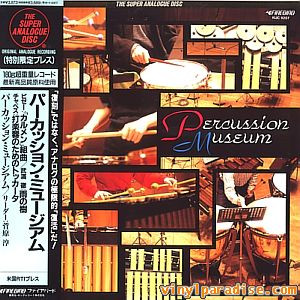 Bizet’s “Carmen Suite” fills out the first side with remarkably dynamic sonics. While this side opens with an incredibly quiet tympani and chime passage, it soon soars, with marimbas, chimes, snare drums, and a myriad of other percussion instruments. I was hearing entirely newfound power, especially in the lower registers, as well as markedly improved clarity across the entire bandwidth, from all instruments, resulting in the “essence” and “space” of the hall now being even more superbly captured.
Bizet’s “Carmen Suite” fills out the first side with remarkably dynamic sonics. While this side opens with an incredibly quiet tympani and chime passage, it soon soars, with marimbas, chimes, snare drums, and a myriad of other percussion instruments. I was hearing entirely newfound power, especially in the lower registers, as well as markedly improved clarity across the entire bandwidth, from all instruments, resulting in the “essence” and “space” of the hall now being even more superbly captured.
And while this attribute was starkly apparent in the lowest reaches, it also impacted system performance broadband, reaching all the way on up into the uppermost octaves. The overall result of this elevated, clearer, and more apparent resolution included a newfound expressiveness, especially in microdynamic subtlety, and an unmistakable cultivation of system transparency. With them in place, tonal vibrancy had become more expressive, and texture and color were more faithful and complex.
And talk about rendering an immersive and convincing sense of space! Another result of this newfound transparency was that everything had assumed a fresh and more authentic dimensionality, revealing spatial cues more three-dimensional, more accurately sized, and fundamentally more correct, resulting in more engaging interplay and interrelationships among instrumental lines and arrangements.
One more especially important note on the results of using these utterly remarkable footers. Don’t think for one moment that you have to have a mega-system to reap their abundant benefits. Their profusion of gifts works with every level of gear anyone I know has tried them with. In fact, after my original take was published, and there was some substantial push back from those who just didn’t get it, one loudspeaker designer stated that he would rather listen to his more modestly priced electronics (~$10,000 for a linestage and stereo amplifier) sitting on the CenterStage footers than to his much more costly electronics (~$35,000 for a linestage and stereo amplifier) without them! They are that effective…seriously.
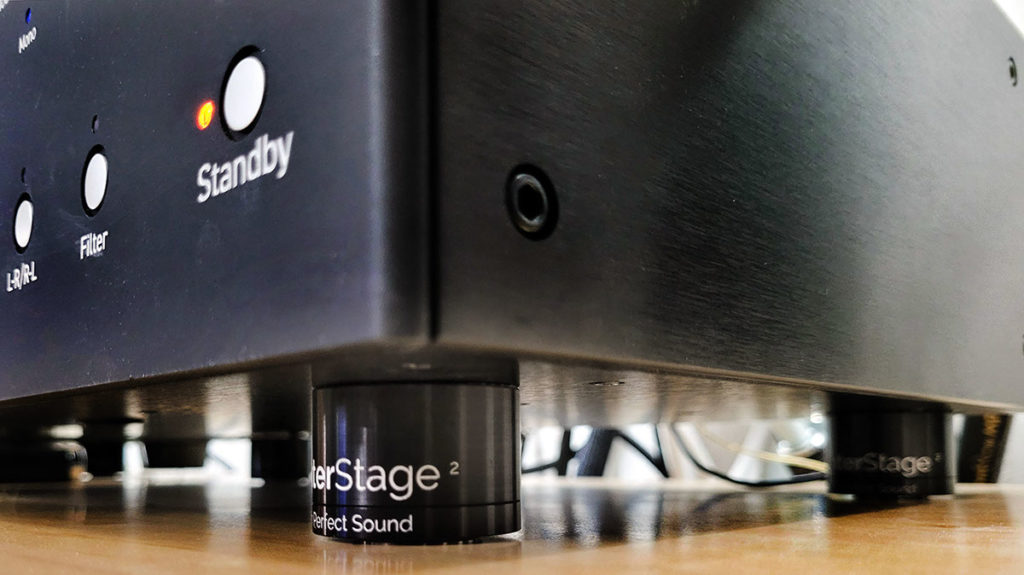 As to meeting his original design goals for the Center Stage2M footers, I have to tip my hat to Joe by acknowledging that the sonic results seem to better the previous Center Stage2 performance by nearly a doubling. Overall, I find the Critical Mass Systems Center Stage2Ms to be significantly more refined than their predecessors, allowing for a much more cohesive sound from the entire system, transferring it considerably more closely towards the sound of live performance.
As to meeting his original design goals for the Center Stage2M footers, I have to tip my hat to Joe by acknowledging that the sonic results seem to better the previous Center Stage2 performance by nearly a doubling. Overall, I find the Critical Mass Systems Center Stage2Ms to be significantly more refined than their predecessors, allowing for a much more cohesive sound from the entire system, transferring it considerably more closely towards the sound of live performance.
And not only do I see the performance of the 0.8 CenterStage2M to be nearly twice as effective as the original 0.8 Center Stage2, but I find the 0.8 CenterStage2M performance easily eclipses the results of the earlier 1.0 Center Stage2. And I’m here to tell you, that the CenterStage2M 1.5 should not be underestimated, as its performance borders on earth-shaking! The fact that CMS has maintained a price structure so close to that of the older Center Stage2 should be lauded as just another gift to music lovers the world over.
The quality of improvement and enhancement that these game-changing footers offer in the realms of better extension, definition, and speed, at both extremes, of tonal purity, dynamic prowess, both macro and micro, and especially those of resolution, soundstaging, imaging, and the resultant immersiveness they engender, are benefits that you simply may not be able to achieve or replicate in any other way, even with a doubling, or tripling, of your investment in your components! Read that again because I’m deadly serious. And as much uproar and kerfuffle as that statement made with my assessment on the original footers when published, it is even truer with the Center Stage2Ms.
At this time, they represent the pinnacle of performance from any isolation product I’ve experienced and should be considered an absolute necessity for any music-loving audiophile. I have since been privileged to add several more sets of the 1.0 Center Stage2M footers to my system, and it has only taken me even closer to my beloved music. I again share my highest recommendation for these innovative and revolutionary products. Go get yours and finally hear what your gear really sounds like!
Product Details
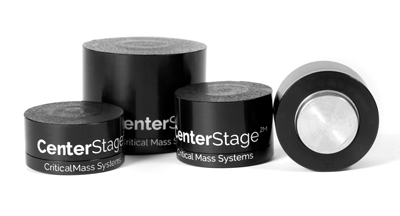 Center Stage2M 0.8
Center Stage2M 0.8
1.5” in diameter with a height of 13/16” (38mm x 20.6mm). +/- 5 microns
Weight: 2 ounces.
Price: $280 each
Center Stage2M 1.0
1.5” in diameter with a height of 1.0” (38 mm x 25.4mm). +/- 5 microns
Weight: 3 ounces each
Price: $545 each
Center Stage2M 1.5
2” in diameter with a height of 1.5” (50.8mm x 38mm). +/- 5 microns
Weight: 10 ounces each.
Price: $795 each
 The website tells us that by further implementing tested design fundamentals from within the discipline of material science to determine both the correct sequencing and use of the Center Stage2M materials, they were able to establish what they now define as the proper “proportional applications” of all the materials. Finally, they were able to address the inclusion of the proper amount of added damping in their very last stage to eliminate the internal noise of both the footers, and the component resting on them, without rolling off the top end of the acoustic envelope.
The website tells us that by further implementing tested design fundamentals from within the discipline of material science to determine both the correct sequencing and use of the Center Stage2M materials, they were able to establish what they now define as the proper “proportional applications” of all the materials. Finally, they were able to address the inclusion of the proper amount of added damping in their very last stage to eliminate the internal noise of both the footers, and the component resting on them, without rolling off the top end of the acoustic envelope. I’ll admit to finding it hard to imagine that Joe could have somehow found a way to leverage any further significant sonic enhancement from this new model over the remarkable performance he had extracted from the Center Stage2 over the original Center Stage. I should have known better!
I’ll admit to finding it hard to imagine that Joe could have somehow found a way to leverage any further significant sonic enhancement from this new model over the remarkable performance he had extracted from the Center Stage2 over the original Center Stage. I should have known better! Bizet’s “Carmen Suite” fills out the first side with remarkably dynamic sonics. While this side opens with an incredibly quiet tympani and chime passage, it soon soars, with marimbas, chimes, snare drums, and a myriad of other percussion instruments. I was hearing entirely newfound power, especially in the lower registers, as well as markedly improved clarity across the entire bandwidth, from all instruments, resulting in the “essence” and “space” of the hall now being even more superbly captured.
Bizet’s “Carmen Suite” fills out the first side with remarkably dynamic sonics. While this side opens with an incredibly quiet tympani and chime passage, it soon soars, with marimbas, chimes, snare drums, and a myriad of other percussion instruments. I was hearing entirely newfound power, especially in the lower registers, as well as markedly improved clarity across the entire bandwidth, from all instruments, resulting in the “essence” and “space” of the hall now being even more superbly captured. As to meeting his original design goals for the Center Stage2M footers, I have to tip my hat to Joe by acknowledging that the sonic results seem to better the previous Center Stage2 performance by nearly a doubling. Overall, I find the Critical Mass Systems Center Stage2Ms to be significantly more refined than their predecessors, allowing for a much more cohesive sound from the entire system, transferring it considerably more closely towards the sound of live performance.
As to meeting his original design goals for the Center Stage2M footers, I have to tip my hat to Joe by acknowledging that the sonic results seem to better the previous Center Stage2 performance by nearly a doubling. Overall, I find the Critical Mass Systems Center Stage2Ms to be significantly more refined than their predecessors, allowing for a much more cohesive sound from the entire system, transferring it considerably more closely towards the sound of live performance. Center Stage2M 0.8
Center Stage2M 0.8
